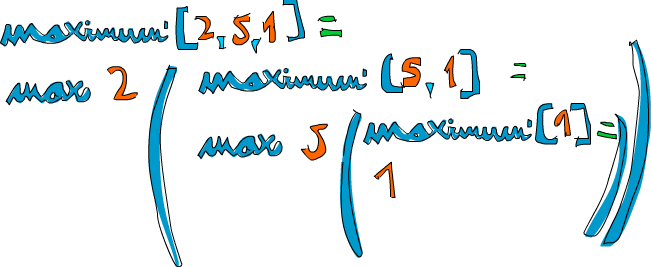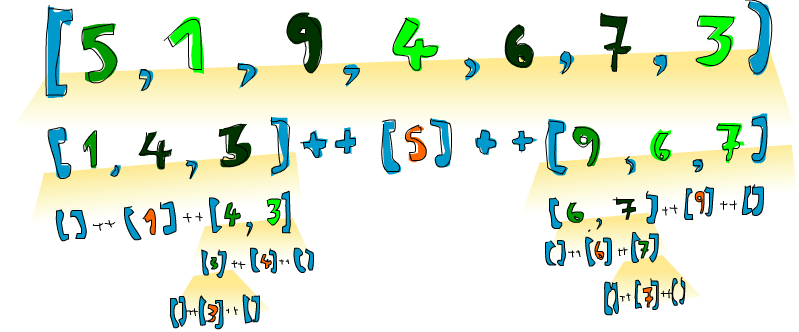Recursion
Hello recursion!

We mention recursion briefly in the previous chapter. In this chapter, we’ll take a closer look at recursion, why it’s important to Haskell and how we can work out very concise and elegant solutions to problems by thinking recursively.
If you still don’t know what recursion is, read this sentence. Haha! Just kidding! Recursion is actually a way of defining functions in which the function is applied inside its own definition. Definitions in mathematics are often given recursively. For instance, the fibonacci sequence is defined recursively. First, we define the first two fibonacci numbers non-recursively. We say that F(0) = 0 and F(1) = 1, meaning that the 0th and 1st fibonacci numbers are 0 and 1, respectively. Then we say that for any other natural number, that fibonacci number is the sum of the previous two fibonacci numbers. So F(n) = F(n-1) + F(n-2). That way, F(3) is F(2) + F(1), which is (F(1) + F(0)) + F(1). Because we’ve now come down to only non-recursively defined fibonacci numbers, we can safely say that F(3) is 2. Having an element or two in a recursion definition defined non-recursively (like F(0) and F(1) here) is also called the edge condition and is important if you want your recursive function to terminate. If we hadn’t defined F(0) and F(1) non recursively, you’d never get a solution any number because you’d reach 0 and then you’d go into negative numbers. All of a sudden, you’d be saying that F(-2000) is F(-2001) + F(-2002) and there still wouldn’t be an end in sight!
Recursion is important to Haskell because unlike imperative languages, you do computations in Haskell by declaring what something is instead of declaring how you get it. That’s why there are no while loops or for loops in Haskell and instead we many times have to use recursion to declare what something is.
Maximum awesome
The maximum function takes a list of things that can be
ordered (e.g. instances of the Ord typeclass) and returns
the biggest of them. Think about how you’d implement that in an
imperative fashion. You’d probably set up a variable to hold the maximum
value so far and then you’d loop through the elements of a list and if
an element is bigger than then the current maximum value, you’d replace
it with that element. The maximum value that remains at the end is the
result. Whew! That’s quite a lot of words to describe such a simple
algorithm!
Now let’s see how we’d define it recursively. We could first set up an edge condition and say that the maximum of a singleton list is equal to the only element in it. Then we can say that the maximum of a longer list is the head if the head is bigger than the maximum of the tail. If the maximum of the tail is bigger, well, then it’s the maximum of the tail. That’s it! Now let’s implement that in Haskell.
maximum' :: (Ord a) => [a] -> a
maximum' [] = error "maximum of empty list"
maximum' [x] = x
maximum' (x:xs)
| x > maxTail = x
| otherwise = maxTail
where maxTail = maximum' xsAs you can see, pattern matching goes great with recursion! Most imperative languages don’t have pattern matching so you have to make a lot of if else statements to test for edge conditions. Here, we simply put them out as patterns. So the first edge condition says that if the list is empty, crash! Makes sense because what’s the maximum of an empty list? I don’t know. The second pattern also lays out an edge condition. It says that if it’s the singleton list, just give back the only element.
Now the third pattern is where the action happens. We use pattern
matching to split a list into a head and a tail. This is a very common
idiom when doing recursion with lists, so get used to it. We use a
where binding to define maxTail as the maximum of
the rest of the list. Then we check if the head is greater than the
maximum of the rest of the list. If it is, we return the head.
Otherwise, we return the maximum of the rest of the list.
Let’s take an example list of numbers and check out how this would
work on them: [2,5,1]. If we call maximum' on
that, the first two patterns won’t match. The third one will and the
list is split into 2 and [5,1]. The
where clause wants to know the maximum of [5,1],
so we follow that route. It matches the third pattern again and
[5,1] is split into 5 and [1].
Again, the where clause wants to know the maximum of
[1]. Because that’s the edge condition, it returns
1. Finally! So going up one step, comparing 5
to the maximum of [1] (which is 1), we
obviously get back 5. So now we know that the maximum of
[5,1] is 5. We go up one step again where we
had 2 and [5,1]. Comparing 2 with
the maximum of [5,1], which is 5, we choose
5.
An even clearer way to write this function is to use
max. If you remember, max is a function that
takes two numbers and returns the bigger of them. Here’s how we could
rewrite maximum' by using max:
maximum' :: (Ord a) => [a] -> a
maximum' [] = error "maximum of empty list"
maximum' [x] = x
maximum' (x:xs) = max x (maximum' xs)How’s that for elegant! In essence, the maximum of a list is the max of the first element and the maximum of the tail.

A few more recursive functions
Now that we know how to generally think recursively, let’s implement
a few functions using recursion. First off, we’ll implement
replicate. replicate takes an Int
and some element and returns a list that has several repetitions of the
same element. For instance, replicate 3 5 returns
[5,5,5]. Let’s think about the edge condition. My guess is
that the edge condition is 0 or less. If we try to replicate something
zero times, it should return an empty list. Also for negative numbers,
because it doesn’t really make sense.
replicate' :: (Num i, Ord i) => i -> a -> [a]
replicate' n x
| n <= 0 = []
| otherwise = x:replicate' (n-1) xWe used guards here instead of patterns because we’re testing for a
boolean condition. If n is less than or equal to 0, return
an empty list. Otherwise, return a list that has x as the
first element and then x replicated n-1 times as the tail.
Eventually, the (n-1) part will cause our function to reach
the edge condition.
Note: Num is not a subclass of
Ord. This is because not every number type has an ordering,
e.g. complex numbers aren’t ordered. So that’s why we have to specify
both the Num and Ord class constraints when
doing addition or subtraction and also comparison.
Next up, we’ll implement take. It takes a certain number
of elements from a list. For instance, take 3 [5,4,3,2,1]
will return [5,4,3]. If we try to take 0 or fewer elements
from a list, we get an empty list. Also if we try to take anything from
an empty list, we get an empty list. Notice that those are two edge
conditions right there. So let’s write that out:
take' :: (Num i, Ord i) => i -> [a] -> [a]
take' n _
| n <= 0 = []
take' _ [] = []
take' n (x:xs) = x : take' (n-1) xs
The first pattern specifies that if we try to take a 0 or negative
number of elements, we get an empty list. Notice that we’re using
_ to match the list because we don’t really care what it is
in this case. Also notice that we use a guard, but without an
otherwise part. That means that if n turns out
to be more than 0, the matching will fall through to the next pattern.
The second pattern indicates that if we try to take anything from an
empty list, we get an empty list. The third pattern breaks the list into
a head and a tail. And then we state that taking n elements
from a list equals a list that has x as the head and then a
list that takes n-1 elements from the tail as a tail. Try
using a piece of paper to write down how the evaluation would look like
if we try to take, say, 3 from [4,3,2,1].
reverse simply reverses a list. Think about the edge
condition. What is it? Come on … it’s the empty list! An empty list
reversed equals the empty list itself. O-kay. What about the rest of it?
Well, you could say that if we split a list to a head and a tail, the
reversed list is equal to the reversed tail and then the head at the
end.
reverse' :: [a] -> [a]
reverse' [] = []
reverse' (x:xs) = reverse' xs ++ [x]There we go!
Because Haskell supports infinite lists, our recursion doesn’t really
have to have an edge condition. But if it doesn’t have it, it will
either keep churning at something infinitely or produce an infinite data
structure, like an infinite list. The good thing about infinite lists
though is that we can cut them where we want. repeat takes
an element and returns an infinite list that just has that element. A
recursive implementation of that is really easy, watch.
repeat' :: a -> [a]
repeat' x = x:repeat' xCalling repeat 3 will give us a list that starts with
3 and then has an infinite amount of 3’s as a tail. So
calling repeat 3 would evaluate like
3:repeat 3, which is 3:(3:repeat 3), which is
3:(3:(3:repeat 3)), etc. repeat 3 will never
finish evaluating, whereas take 5 (repeat 3) will give us a
list of five 3’s. So essentially it’s like doing
replicate 5 3.
zip takes two lists and zips them together.
zip [1,2,3] [2,3] returns [(1,2),(2,3)],
because it truncates the longer list to match the length of the shorter
one. How about if we zip something with an empty list? Well, we get an
empty list back then. So there’s our edge condition. However,
zip takes two lists as parameters, so there are actually
two edge conditions.
zip' :: [a] -> [b] -> [(a,b)]
zip' _ [] = []
zip' [] _ = []
zip' (x:xs) (y:ys) = (x,y):zip' xs ysFirst two patterns say that if the first list or second list is
empty, we get an empty list. The third one says that two lists zipped
are equal to pairing up their heads and then tacking on the zipped
tails. Zipping [1,2,3] and ['a','b'] will
eventually try to zip [3] with []. The edge
condition patterns kick in and so the result is
(1,'a'):(2,'b'):[], which is exactly the same as
[(1,'a'),(2,'b')].
Let’s implement one more standard library function —
elem. It takes an element and a list and sees if that
element is in the list. The edge condition, as is most of the times with
lists, is the empty list. We know that an empty list contains no
elements, so it certainly doesn’t have the droids we’re looking for.
elem' :: (Eq a) => a -> [a] -> Bool
elem' a [] = False
elem' a (x:xs)
| a == x = True
| otherwise = a `elem'` xsPretty simple and expected. If the head isn’t the element then we
check the tail. If we reach an empty list, the result is
False.
Quick, sort!
We have a list of items that can be sorted. Their type is an instance
of the Ord typeclass. And now, we want to sort them!
There’s a very cool algorithm for sorting called quicksort. It’s a very
clever way of sorting items. While it takes upwards of 10 lines to
implement quicksort in imperative languages, the implementation is much
shorter and elegant in Haskell. Quicksort has become a sort of poster
child for Haskell. Therefore, let’s implement it here, even though
implementing quicksort in Haskell is considered really cheesy because
everyone does it to showcase how elegant Haskell is.

So, the type signature is going to be
quicksort :: (Ord a) => [a] -> [a]. No surprises
there. The edge condition? Empty list, as is expected. A sorted empty
list is an empty list. Now here comes the main algorithm: a
sorted list is a list that has all the values smaller than (or equal to)
the head of the list in front (and those values are sorted), then comes
the head of the list in the middle and then come all the values that are
bigger than the head (they’re also sorted). Notice that we said
sorted two times in this definition, so we’ll probably have to
make the recursive call twice! Also notice that we defined it using the
verb is to define the algorithm instead of saying do this,
do that, then do that …. That’s the beauty of functional
programming! How are we going to filter the list so that we get only the
elements smaller than the head of our list and only elements that are
bigger? List comprehensions. So, let’s dive in and define this
function.
quicksort :: (Ord a) => [a] -> [a]
quicksort [] = []
quicksort (x:xs) =
let smallerSorted = quicksort [a | a <- xs, a <= x]
biggerSorted = quicksort [a | a <- xs, a > x]
in smallerSorted ++ [x] ++ biggerSortedLet’s give it a small test run to see if it appears to behave correctly.
ghci> quicksort [10,2,5,3,1,6,7,4,2,3,4,8,9]
[1,2,2,3,3,4,4,5,6,7,8,9,10]
ghci> quicksort "the quick brown fox jumps over the lazy dog"
" abcdeeefghhijklmnoooopqrrsttuuvwxyz"Booyah! That’s what I’m talking about! So if we have, say
[5,1,9,4,6,7,3] and we want to sort it, this algorithm will
first take the head, which is 5 and then put it in the
middle of two lists that are smaller and bigger than it. So at one
point, you’ll have [1,4,3] ++ [5] ++ [9,6,7]. We know that
once the list is sorted completely, the number 5 will stay
in the fourth place since there are 3 numbers lower than it and 3
numbers higher than it. Now, if we sort [1,4,3] and
[9,6,7], we have a sorted list! We sort the two lists using
the same function. Eventually, we’ll break it up so much that we reach
empty lists and an empty list is already sorted in a way, by virtue of
being empty. Here’s an illustration:

An element that is in place and won’t move anymore is represented in orange. If you read them from left to right, you’ll see the sorted list. Although we chose to compare all the elements to the heads, we could have used any element to compare against. In quicksort, an element that you compare against is called a pivot. They’re in green here. We chose the head because it’s easy to get by pattern matching. The elements that are smaller than the pivot are light green and elements larger than the pivot are dark green. The yellowish gradient thing represents an application of quicksort.
Thinking recursively
We did quite a bit of recursion so far and as you’ve probably noticed, there’s a pattern here. Usually you define an edge case and then you define a function that does something between some element and the function applied to the rest. It doesn’t matter if it’s a list, a tree or any other data structure. A sum is the first element of a list plus the sum of the rest of the list. A product of a list is the first element of the list times the product of the rest of the list. The length of a list is one plus the length of the tail of the list. Et cetera, et cetera…

Of course, these also have edge cases. Usually the edge case is some scenario where a recursive application doesn’t make sense. When dealing with lists, the edge case is most often the empty list. If you’re dealing with trees, the edge case is usually a node that doesn’t have any children.
It’s similar when you’re dealing with numbers recursively. Usually it has to do with some number and the function applied to that number modified. We did the factorial function earlier and it’s the product of a number and the factorial of that number minus one. Such a recursive application doesn’t make sense with zero, because factorials are defined only for positive integers. Often the edge case value turns out to be an identity. The identity for multiplication is 1 because if you multiply something by 1, you get that something back. Also when doing sums of lists, we define the sum of an empty list as 0 and 0 is the identity for addition. In quicksort, the edge case is the empty list and the identity is also the empty list, because if you add an empty list to a list, you just get the original list back.
So when trying to think of a recursive way to solve a problem, try to think of when a recursive solution doesn’t apply and see if you can use that as an edge case, think about identities and think about whether you’ll break apart the parameters of the function (for instance, lists are usually broken into a head and a tail via pattern matching) and on which part you’ll use the recursive call.